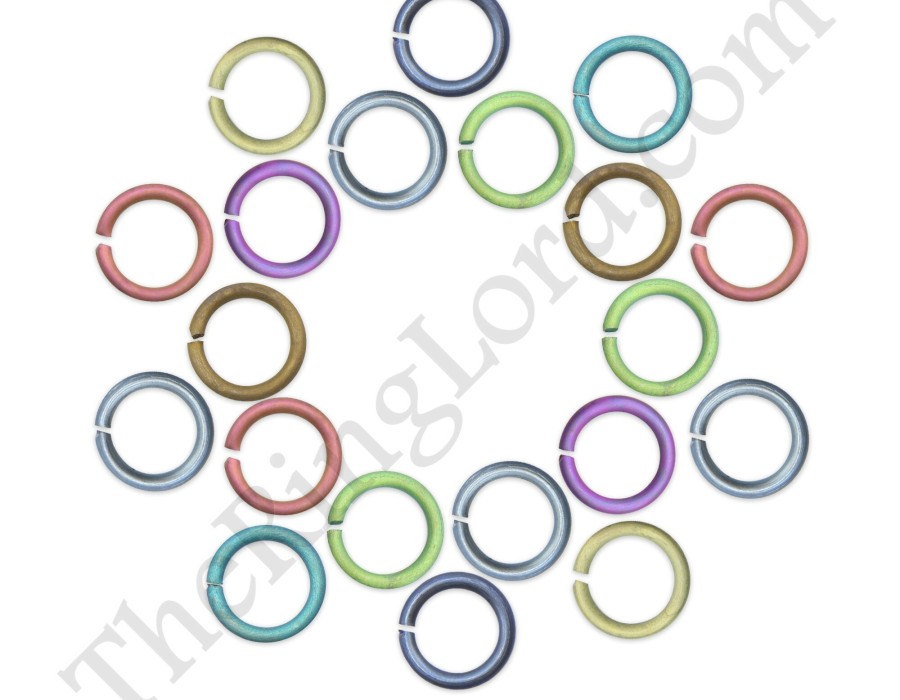Titanium jump rings have become increasingly popular among jewelry makers, and for good reason. Known for their incredible strength, lightweight nature, and resistance to corrosion, titanium jump rings provide a reliable and versatile option for crafting jewelry that is both durable and stylish. Whether you’re creating chainmaille pieces, necklaces, bracelets, or intricate earrings, titanium jump rings offer unique benefits that make them an essential addition to any jewelry maker’s toolkit.
1. Exceptional Strength and Durability
One of the most significant advantages of titanium jump rings is their strength. Titanium is a metal that rivals stainless steel in durability but is much lighter, making it ideal for jewelry that needs to withstand daily wear and tear. Unlike softer metals such as aluminum or copper, titanium jump rings maintain their shape over time, even under tension or weight. This makes them perfect for creating sturdy chainmaille weaves, keychains, or heavy-duty statement pieces without the risk of deformation.
Their durability also means that titanium jewelry is less likely to break or bend when accidentally snagged or pulled, providing longevity and reliability that other metals may not offer. For artisans creating high-quality, professional pieces, titanium jump rings are an investment in the longevity and resilience of their work.
2. Lightweight Comfort
Despite their impressive strength, titanium jump rings are exceptionally lightweight. This makes them comfortable to wear, even in larger designs that use multiple rings or heavy chainmaille patterns. Jewelry made with heavier metals can become uncomfortable over time, especially for bracelets, necklaces, or earrings. Titanium offers the perfect balance: strong enough to provide durability, yet light enough to ensure wearer comfort.
This characteristic is particularly beneficial for jewelry designers creating statement pieces or layered chainmaille designs. You can incorporate larger numbers of rings into your projects without making the finished piece cumbersome, which expands creative possibilities.
3. Corrosion and Tarnish Resistance
Titanium is naturally resistant to corrosion, tarnish, and oxidation. Unlike copper, brass, or even some plated metals, titanium jump rings do not discolor or react to moisture, sweat, or environmental exposure. This makes them ideal for jewelry that will be worn daily or exposed to water, humidity, or outdoor conditions.
For jewelry makers, this means less maintenance for both themselves and the end wearer. Titanium jump rings retain their sleek, polished appearance for years, providing a professional finish without the need for frequent cleaning or polishing. This property also makes titanium an excellent choice for high-quality chainmaille pieces or jewelry intended for gifts, as the longevity of the material enhances the perceived value.
4. Hypoallergenic Qualities
Another key benefit of titanium jump rings is that titanium is hypoallergenic. Many people have sensitivities to metals like nickel or copper, which can cause skin irritation or allergic reactions. Titanium, however, is safe for most skin types, making it an excellent option for earrings, necklaces, and other pieces that come into direct contact with the skin.
Jewelry makers creating products for customers with sensitive skin can confidently use titanium jump rings, knowing that their pieces will be both safe and comfortable to wear. This feature has contributed to titanium’s growing popularity in both fashion and medical jewelry markets.
5. Versatility in Design
Titanium jump rings are available in various wire gauges, diameters, and finishes, allowing jewelry makers to experiment with different designs and styles. From minimalist single-ring earrings to complex chainmaille weaves like Byzantine, Box, or European 4-in-1 patterns, titanium’s strength supports both delicate and intricate designs.
Additionally, titanium can be anodized to produce vibrant colors without compromising its durability. This opens the door for creative, eye-catching designs that combine strength with aesthetic appeal. Anodized titanium jump rings retain their color over time and resist fading, allowing artisans to add pops of color or thematic elements to their work.
6. Easy to Work With (with Proper Tools)
Although titanium is a strong metal, it is still workable with the right tools. Jewelry makers typically use two pairs of pliers—chain-nose or flat-nose—to open and close jump rings. Because titanium is harder than softer metals like aluminum, using smooth-jaw pliers is recommended to prevent scratching the metal’s surface.
With proper technique, titanium jump rings can be manipulated just like any other metal, allowing artisans to explore intricate weaves and complex designs. While beginners may need some practice to handle the metal efficiently, the resulting durability and longevity make it worth the effort.
7. Applications in Various Jewelry Projects
Titanium jump rings can be used in a wide range of jewelry projects. They are ideal for:
- Chainmaille Jewelry: Durable rings hold complex weaves together without deforming.
- Bracelets and Necklaces: Lightweight yet strong, perfect for daily wear.
- Earrings: Safe for sensitive ears and comfortable to wear.
- Mixed-Metal Designs: Pairs well with stainless steel, silver, or anodized rings for contrast and creative effects.
- Keychains and Accessories: Titanium’s strength supports heavier designs or functional items.
Conclusion
Titanium jump rings combine strength, durability, lightweight comfort, and hypoallergenic properties, making them a must-have for jewelry makers. Their resistance to corrosion and tarnish, along with their ability to hold color through anodization, ensures that jewelry made from titanium jump rings remains vibrant and reliable over time.
Whether you’re crafting intricate chainmaille patterns, bold statement pieces, or delicate everyday jewelry, titanium jump rings offer unmatched performance and aesthetic appeal. By incorporating titanium into your designs, you can create pieces that are not only beautiful but also durable, safe, and long-lasting—qualities that both artisans and customers value.





Comments